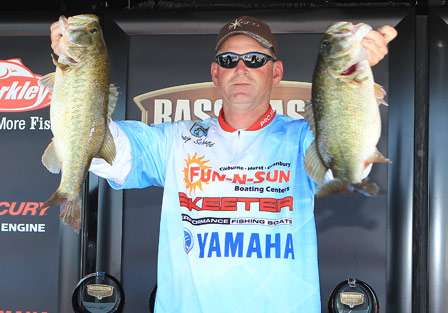
The first Central Open of the 2010 season is in the books. Each of the two top anglers chose a different bait as their primary weapon but managed to find fish in the same neighborhood, under similar conditions. The biggest bass of the event was caught by a competitor fishing a familiar big bass spot using an unconventional tactic.
Here's how they tell the story:
Craig Schuff
(1st place — 68 pounds, 9 ounces)
First, let me say that this was not my win, nor was it my plan. It was the Lord's work. He's responsible for everything. I also want to say thanks to my friend Patch Mason for his help in preparing for this tournament.
During practice I realized a lot of the guys would be fishing beds. I didn't want to do that so I targeted prespawn and postspawn fish. I found a great spot back in a bay. It was about 400 yards long with three ditches running through it.
The ditches made small but significant points under the water. The area was covered with trees and was home to two scattered grass patches — one was old and brown, the other new and green.
I caught most of my bass on a 6-inch Osprey Talon swimbait in Light Hitch. It was the right size and color to match the forage, and I could work it through the brush without hanging every five minutes.
The toughest part of this thing was following the bass. On the first day they were up shallow in about 12 feet of water between the ditches. On the second day they moved into the ditches 15 to 18 feet under the surface. Then on Saturday they moved back shallow.
The grass also produced at times. At least four big keepers came from that one little spot of green grass and another two off the dead stuff.
The bass were biting light and without much enthusiasm. The key was to work the bait slow — just fast enough so I could feel the weight of it — 2 or 3 feet off the bottom. Nothing fancy, just a basic slow retrieve.
I fished my Osprey on a 7 foot, 3 inch Falcon Cara Amistad rod (heavy action) and a Shimano Curado reel spooled with 25-pound-test Seaguar InvizX line. I have no idea what the gear ratio is on my reel, but I do know it takes up 26 inches of line per crank.
Ray Hanselman Jr.
(2nd place — 67 pounds, 9 ounces)
Beds are not my thing. I was fishing the same bay (and for the same reasons) as Schuff only about a half-mile away. The bass were moving in and out of it, so there was a constant supply of fish.
The flat was covered with grass, but only a short strip — maybe 50 yards — was green. The fish stacked up on it and were really active. My best two baits were both Texas rigged worms. I fished the first two days with a Zoom Trick Worm (Watermelon Candy), but on the last day I had better luck with a Berkley 10-inch Power Worm (Red Flake and Watermelon Candy).
My weight was critically important. I fished a 3/16-ounce Tru-Tungsten sinker with the Zoom Trick Worm and a 1/4-ounce weight with the Berkley Power Worm. Those lighter weights allowed me to snap my rig up out of the grass and then let it fall slowly back down.
Light weights can be a hassle in the wind, but they're well worth the effort. On Amistad, the traditional lift and drop doesn't work very well. You need that fast snap and slow fall. I have no idea why, but years of guiding on Amistad (www.amistadfishingguide.com) have proved it to be true over and over again.
I threw my worms on a 7 foot, 6 inch Power Tackle rod (medium action) and a Shimano Curado E7 reel (7:1 gear ratio) spooled with 16-pound-test Gamma Edge Fluorocarbon line.
Lisa Sternard
(Big bass — 10 pounds, 4 ounces)
We — my partner and I — had a limit early the first day, so we went hunting for a big fish. I selected a main lake flat in about 18 feet of water with scattered hydrilla. It was the same kind of place I caught my 10-pounder in 2007.
The bites were extremely light, so I went with a Carolina rig. I've had better success pulling my bait up from deep water into shallow water with slow pulls and long pauses when the bite is off, so that's what I did here.
My Zoom Big Dead Ringer (Watermelon Red) was attached to a 5-foot leader by means of a Gamakatsu 4/0 Extra Wide Gap Hook. Everything was weighted with a 1-ounce egg sinker. My leader was 17-pound-test Berkley Vanish, and my main line was 30-pound-test Spiderwire. I used a custom made, 7-foot medium-heavy action John Miles rod and an Ambassadeur 5501 reel (left-hand retrieve).
Amistad is definitely a big bass lake. In addition to my big bass of the tournament I boated a 10-11 in practice and lost one the second day I'd estimate at about 13 pounds.
